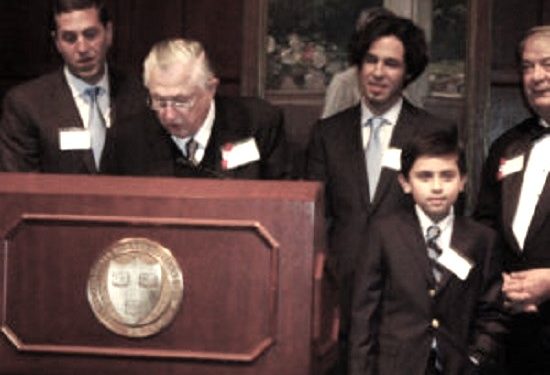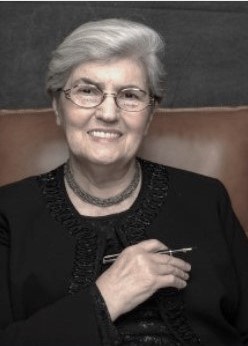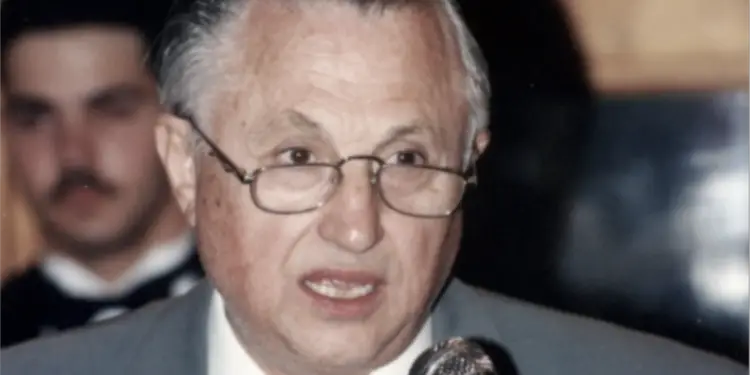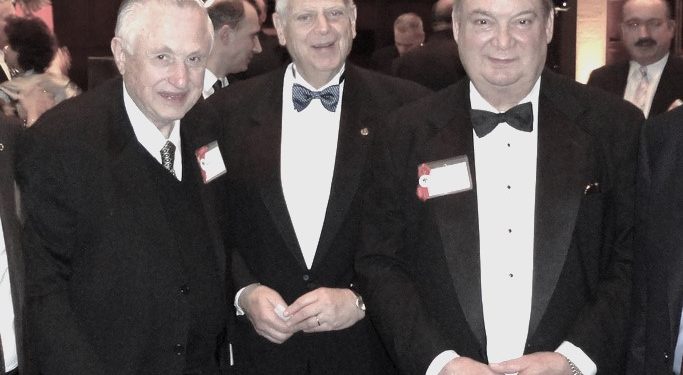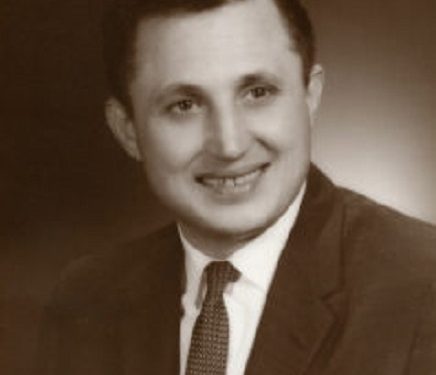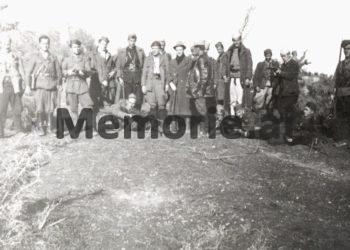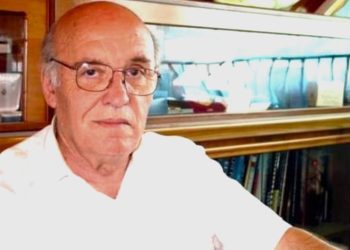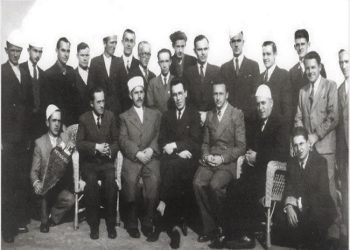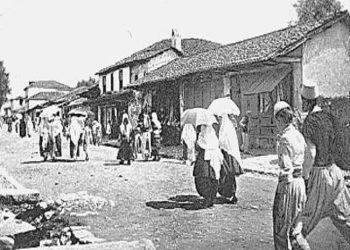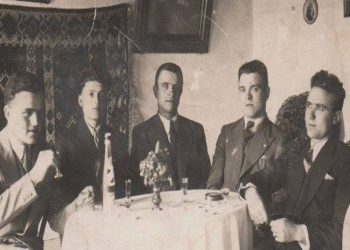From Pertefe Leka
Dr. Agim Leka, the intellectual who corrected the 1961 Encyclopedia Britannica regarding the historical authenticity of Skanderbeg, which portrayed our National Hero as having Serbian origins?! –
Memorie.al / Dr. Agim Leka is well-known and respected in the Albanian-American community for his contributions to the field of medicine. In the doctor, humanism and patriotism are embodied as an inseparable whole, reflected in his contemporary activities, including journalism. It is of interest to recognize and study the writings of Dr. Leka due to the themes he has addressed. As January marks the anniversary of Skanderbeg’s death, for whom he fought with an unmatched determination and will to correctly write the Albanian origins of our National Hero, he has original documents, but also much more in his brilliant memory. Even though this month marks the 93rd anniversary of the Doctor’s birth, researchers have the opportunity to connect and obtain information regarding their interests.
What events inspired him?
Initially, the journalism of young Leka is intertwined with his age of education and intellectual formation in the best Albanian and European schools. Raised in an intellectual family with patriotic and educational traditions and invested by his father, Av. Rakip Leka (a student of ‘Zosimea’ and of Law at the University of Istanbul), he prioritized educating and enlightening the minds of youth for knowledge. Thus, young Leka was a student at the Korça High School, the State Lyceum of Tirana, in Prato, Florence, in Salzburg, Austria, up to the University of Rome, where he graduated in the field of medicine.
This is how his personality grew and he formed as an intellectual with a broad culture and knowledge of many foreign languages. Even at a very young age, he had formed his own beliefs, which he himself states: “At a time when most of my classmates at the State Lyceum of Tirana, with their undeniable idealism for the liberation of our Homeland and the construction of a ‘new society,’ had embraced a foreign ideology, thinking that ‘Internationalism would be the new world,’ I began to develop my doubts, reinforced by my father, that nothing good would come to our nation from the Slavo-communist world!”
With this decision, young Leka aligned his views with the ideologue of the nationalist movement, Mit’hat Frashëri, and actively participated in the first demonstrations against the occupiers. At the age of 18, he noted that the open resistance against the Italian occupier began also from the Albanian pen, from Shkodra and Teuta, from Dom Nikollë Mazrreku, who gave the well-deserved response to the Italian priest, Fulvio Cordiniano.
When the Italian priest attacked the dignity of the Albanian people in the infamous publication “Revista d’Albania,” of March 1941, he morally compelled Dom Nikollë Mazrrek, using the pseudonym “Nikë Barcolla,” to write: “The Cordiniano Scandal and the Defense of the Albanian Nation,” signed by Shkodra professors; ‘Cordiniano on trial before the world’!”
This was also the beginning of Dr. Leka’s writings, with the Italian translation of the book by Dom Nikollë Mazrek, whose memory he proudly preserves even today at the age of 93. In this work, Dom Nikollë Mazrek raised high the bravery and wisdom of the Albanian people, opposing Cordiniano and those who had incited him to justify the occupation of Albania as a “civilizing mission.”
Although the Albanian priest was interned in the villages of the highlands and his book was seized, Dr. Leka, in his courageous youth, did not stop translating and insisted on publishing it in Italian, titled “Risposta a Cordignano sui suoi giudici nei riguardi degli Albanesi,” which means “Response to Cordiniano Regarding His Judgments About Albania.”
After much effort, Dr. Leka’s translation saw the light of publication from the “Kastrioti” printing house, in 2000 copies. The translation expanded from 36 pages in the original Albanian to 42 pages, which included in the preface several excerpts from the professors’ protest publication from Shkodra. The copies of the book were distributed like pamphlets among various consulates and among Italians. Dr. Leka detailed this experience in his article; “Nikë Barcolla and the Professors of Shkodra, in Defense of the Albanian Nation.”
In addition to the content, Dr. Leka also valued the call-to-action title of “Nikë Barcolla’s” book, noting a wise saying by Aristotle that the author had written on the cover: “Do not be angry when asked, it is a great folly.” This first work, with pen, of anti-fascist resistance, in September 1941, deserves to be subjected to a special study, along with the long preface written by the translator.
For this, Dr. Leka writes: “My only meeting at the beginning of 1942, to obtain permission from Dom Nikollë Mazrek for the publication of the book I had translated into Italian, without knowing if I would be allowed to publish it, was for me an emotional moment, because here I was sitting, an 18-year-old student, and in front of me was a tall man, dressed in simple clerical garb, who with his pen had inspired thousands of students to demonstrate for freedom. His sweet words and his idealism for our oppressed homeland dominated our conversation.
Immediately, we understood what the duty of every Albanian citizen was, whatever the consequences from the fascist occupier. None of us sought fame or any material gain; it was only a missionary duty that required selflessness. As I wrote in the preface for Italian readers in 1942 (Prefazione traduzione di Agim Leka Borshi), the translation of this book into Italian had no other driving force except for a simple love for the Homeland!”
With this driving force, he continues. In the spring of 1943, when young Leka was in the mountains of Skrapar, with the group of Prof. Abaz Ermenji, he met the head of the English mission in Albania, Colonel McLean, with whom they spoke in French about the resistance movement in Albania. Later, the young Leka’s participation in the “Mukje Conference” in August 1943 is a long story that he recounts even today with a clear memory, as he is now the only living witness of this significant, yet tragic event, from the communist betrayal.
The meeting in the Krujë mountains of nationalist youth with the hero of the April 7 resistance, Major Abaz Kupi, on November 28, 1943, was cooperative. The speech regarding the unification of Albanian nationalists into a common front was delivered by the young Agim Leka, gaining the admiration of the major. Fate brought them together again in America, where Mr. Kupi, at the end of his life, sought the assistance of Dr. Leka and breathed his last in his arms.
All the above-mentioned events, along with encounters with ideologues and other nationalist figures, became a source of inspiration for presenting the protest and resistance of the Albanian people through his writings, which he published in the newspaper “Zëri i Lirisë,” directed by Musine Kokalari. All this activity caught the attention of the communist movement, which targeted him for elimination, as was done with the assassination of Besnik Çano. The wisdom of his father prevented this catastrophe by sending him for studies in Vienna, along with 100 other Albanian students.
This opened the pathway for university studies, which he completed as a student in Italy. Graduating in medicine in Rome, Dr. Leka established himself not only in the field of medicine but also as an intellectual with a Western culture. Having been away from his homeland for many years and connected with many patriots in the USA, he continued to fight for the rights of Albanians in Albania, Kosovo, and Çameri. In September 1957, he published in “The New York Times,” under the pseudonym ‘ILLYRIKUS,’ the article; “For Albanian Freedom, a Positive American Policy is Required.”
The article in question was prompted by Harrison Salisbury’s visit to Albania and his interview with Prime Minister Mehmet Shehu. Here are some excerpts translated by Dr. Leka:
“As an American of Albanian descent, I feel pleased by the interest shown by the ‘New York Times’ in penetrating the strongest part of the iron curtain, right on the shores of the Adriatic Sea, which has been closed off to Western public opinion for more than a decade…! The territorial integrity and independence of Albania were among the fundamental characteristics of United States policy during the time of Woodrow Wilson, whose name symbolizes American pioneering efforts for democracy and justice throughout the world, with particular interest in the survival of small nations…!
Mr. Shehu’s criticism of such a sincere friend of the Albanian people, Mr. Harry T. Fultz, former member of the American Mission and former director of the American Technical School in Tirana, where Mr. Shehu had the privilege of being educated, is a complete fabrication. This is typical of communist demagoguery and demonstrates a shameful disregard for the traditional and permanent Albanian gratitude towards its foreign friends!” (Dr. A. Leka)
Meanwhile, in the article “Letter to the New York Times” from 1969, he protests against the Yugoslav government for the repression they carry out against Kosovo demonstrators. This article was also written by the author in the Albanian language and was published in the newspaper “Dielli” on February 5, 1969.
From which we can quote: “The request of the Kosovars to elevate their status from an ‘Autonomous Province’ within the Serbian Republic to a full Republic is a reasonable, just, and deserved demand, as the people of Kosovo have suffered for decades under Serbian rule.” In Dr. Leka’s journalism, his long effort regarding Skanderbeg’s chapter in the Encyclopedia Britannica, which was considered the largest of its time, is to be appreciated.
The marathon of correspondence begins with the response he receives on August 21, 1961, from Fan Noli, who welcomes Dr. Leka’s request to collaborate in correcting Skanderbeg’s Serbian origins in that Encyclopedia. (From Noli’s original letter: “I enclose a copy of these two pages. As you may know, ‘The story of Scanderbeg’ was my dissertation for my Ph.D. Degree at Boston University. It was published in 1947 by ‘Vatra’, 30 Huntington Ave., Boston 16 Massachusetts.
Another book in which the question is discussed is by Fr. Athanase Gegaj, “L’Albanie et l’Invasion Turque au XV-e Siecle.” It was a doctoral thesis published by the University of Louvain, Belgium, in 1937. All you have to do is call the attention of the editors of the Encyclopedia Britannica to these two books, which are the latest on the subject, both based on archival material.”)
With this guiding letter from Noli, which includes the work “History of Skënderbeu,” with which he defended his dissertation at Boston University, and the work of Fr. Athanas Gega, “Albania in the Turkish Invasion of the 15th Century,” with which he defended his doctoral thesis at the University of Louvain, Belgium, in 1937, Dr. Leka addresses the Editor of the Encyclopedia on November 13, 1961.
In the letter, a request is made for the swift correction of this error, replacing it with a historical fact, according to Noli’s letter orientation…! (“I am the subscriber of the Encyclopedia Britannica and upon reviewing volume 20, page 726 on the topic of Skanderbeg, the national hero of the Albanians, I was surprised to read the assertion that Skanderbeg was of ‘Serbian origin’…), taken from Dr. Leka’s original letter.
On January 8, 1962, Dr. Leka received a response from Leona B. Kraus, Editorial Assistant, who accepted the request to review the article in question. (“We appreciate your writing to us concerning the origin of Skanderbeg in the Britannica article Skanderbeg or George Castriota (volume 20, page 726…).
On January 22, 1962, Dr. Leka informed Bishop Noli about the response he received from the editor, including the relevant letter. On November 8, 1966, after a long wait, Dr. Leka addressed the editor again: Dear Miss Kraus….. expressing his concern about the delay in the correction according to Bishop Noli’s letter, who had passed away a year earlier in 1965, which might have caused Dr. Leka some difficulties in resolving the issue.
On November 18, 1966, Dr. Leka received a letter from Helen L. Carlock, Editorial Assistant, stating that the article on Skanderbeg has been rewritten but will be published in January 1967, authored by Tajar Zavalani (former Program Assistant, Albanian section, B.B.C.), in which the book of Metropolitan Noli is cited in the bibliography. (Dear Dr. Leka/ The rewritten article on SKANDERBEG has not yet been published. It will appear in our 1967 edition, to be published in January 1967, and we enclose a tear sheet of the page. The author is Tayar Zavalani…) from the original letter.
This made Dr. Agim Leka proud, as he realized the historical truth of the National Hero, Gjergj Kastrioti Skanderbeg.
All of this correspondence, Dr. Leka sent to Prof. Aleks Buda, Chairman of the Academy of Sciences of the People’s Republic of Albania, writing among other things: “I read with interest your letter in the newspaper ‘Liria,’ in which you called on the Albanian community in America regarding the gathering of documents related to the life of his Excellency, the late Bishop Fan S. Noli.”
“I had a correspondence with Bishop Noli regarding a protest I made to the ‘Encyclopedia Britannica’ edition of 1961, in which the author referred to Skanderbeg as having Serbian origins…!”
The letter is lengthy and requires separate study, just like all the documentation submitted by Dr. Leka to this institution, to serve researchers continuously. Of significant interest is the article; “The Greek Dilemma of Albania,” published in English in the newspaper “Illyria” of N.Y. and translated and published in many Albanian newspapers.
The article in question is a response to Nikolas Gage, who published an article titled “Kosovo: A Powder Keg” in the “Washington Post” on April 2, 1995. Nikolas Gage conditioned the restoration of Kosovo’s autonomy on granting parallel autonomy to the Greek minority in Albania.
Meanwhile, Dr. Leka draws attention in the article; “The Greek Dilemma of Albania,” stating that; Nikolas Gage, when talking about ethnic minorities in the Balkans, does not mention the Albanian minority in Çameri, which is systematically being Hellenized. This is also a very interesting and courageous study, serving the historical truths of the Albanian people, which have been trampled upon.
The letters and correspondence with Albanian official authorities after the ’90s, as well as with American personalities such as the letter addressed to the first American ambassador in Albania, Ryerson, expressing enthusiasm and hope for significant democratic changes in Albania, are also beautiful and important.
Many Albanian authorities, regardless of political color, have written about Dr. Leka’s contributions to the fields of education and medicine after the ’90s in Albania, as his duty has been guided by sound logic to serve the long-suffering people.
Dr. Leka was fortunate to experience and enjoy the results of his modest contributions made for the independence of Kosovo, and recently with a lengthy writing on the innocence of R. Haradinaj. Thus, Dr. Leka has elevated himself as a distinguished patriot in defense of the national cause and the youthful dream for Greater Albania./Memorie.al




